Prof.dr. J. Gosseye
Professor of Building Ideologies
Shedding light on underexposed aspects of architecture and urban design in the twentieth century. That is the ambition of Janina Gosseye, Professor of Building Ideologies. She considers means such as graphic novels and oral sources to be very well suited to this. “How do political, social and economic developments influence our built environment? What does this mean for residents, commissioning parties, architects and contractors?”
Professor Janina Gosseye joined the Faculty of Architecture and the Built Environment in the autumn of 2020. After living in Belgium, Australia and Switzerland, she traded her position at ETH Zurich for a Delft Technology Fellowship, a scheme designed to attract more female researchers to the university. However, her work is not technology-oriented. During her training as an architect in Brussels, the emphasis was on the humanities.
After also earning a degree in Human Settlements, Janina obtained a doctorate from Leuven in 2012 for her research on leisure facilities constructed by the Flemish government in the post-war period. She subsequently expanded this research on the interaction between the ideology of the welfare state and the built environment, fuelling her keen interest in the interface between architecture, urban design and political and social systems. Janina has been able to develop her own vision regarding this interface in the Department of Architecture in this faculty. This vision forms the foundation of her teaching and research. She includes several efforts under the term Building Ideologies, and views this as a triptych.
The first part of the triptych concerns Profession and Practice. This encompasses research on changes in the professional practice of architects and urban planners in the second half of the twentieth century. For example, how does professionalisation relate to changing regulations as a result of social and political shifts? There is relatively little attention for this in Europe, including the Netherlands. The second part of the triptych, Projects and Programmes involves Janina unravelling histories of specific buildings and spatial developments. How does our built environment embody socio-political ideas and movements? She would like to create space for such research on architecture and urban design history.” Through the third part of the triptych, Perspectives, Janina sheds light on parties that are underrepresented in the historiography of architecture and urban design. One of the methods Janina uses for this is recording oral histories. “What do the experiences of commissioning parties, residents, architects, contractors and others say about the society in which what is built has a position?”
More information
Educational activities, publications and ancillary activities
